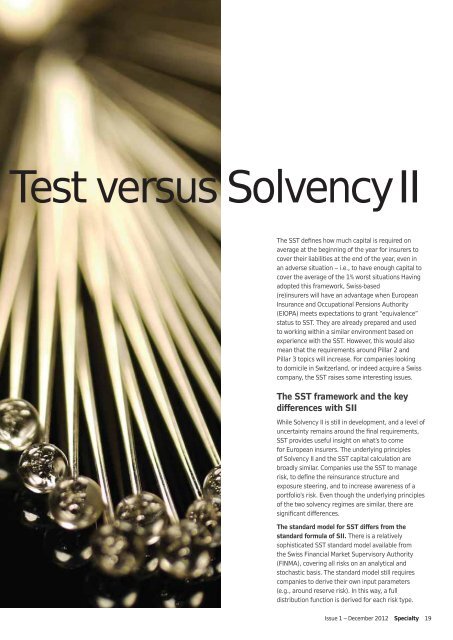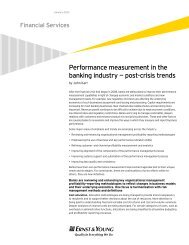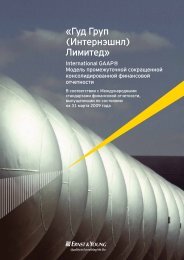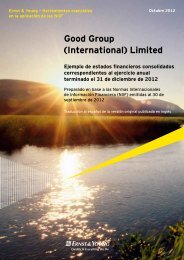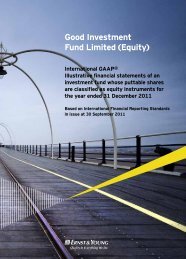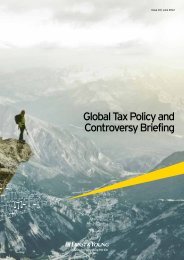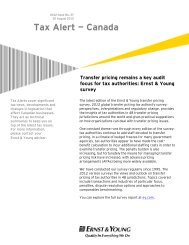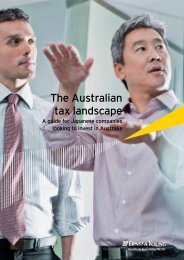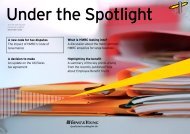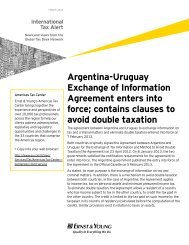Specialty: Insights for the specialty insurance and ... - Ernst & Young
Specialty: Insights for the specialty insurance and ... - Ernst & Young
Specialty: Insights for the specialty insurance and ... - Ernst & Young
You also want an ePaper? Increase the reach of your titles
YUMPU automatically turns print PDFs into web optimized ePapers that Google loves.
Test versus Solvency IIThe SST defines how much capital is required onaverage at <strong>the</strong> beginning of <strong>the</strong> year <strong>for</strong> insurers tocover <strong>the</strong>ir liabilities at <strong>the</strong> end of <strong>the</strong> year, even inan adverse situation — i.e., to have enough capital tocover <strong>the</strong> average of <strong>the</strong> 1% worst situations Havingadopted this framework, Swiss-based(re)insurers will have an advantage when EuropeanInsurance <strong>and</strong> Occupational Pensions Authority(EIOPA) meets expectations to grant “equivalence”status to SST. They are already prepared <strong>and</strong> usedto working within a similar environment based onexperience with <strong>the</strong> SST. However, this would alsomean that <strong>the</strong> requirements around Pillar 2 <strong>and</strong>Pillar 3 topics will increase. For companies lookingto domicile in Switzerl<strong>and</strong>, or indeed acquire a Swisscompany, <strong>the</strong> SST raises some interesting issues.The SST framework <strong>and</strong> <strong>the</strong> keydifferences with SIIWhile Solvency II is still in development, <strong>and</strong> a level ofuncertainty remains around <strong>the</strong> final requirements,SST provides useful insight on what’s to come<strong>for</strong> European insurers. The underlying principlesof Solvency II <strong>and</strong> <strong>the</strong> SST capital calculation arebroadly similar. Companies use <strong>the</strong> SST to managerisk, to define <strong>the</strong> re<strong>insurance</strong> structure <strong>and</strong>exposure steering, <strong>and</strong> to increase awareness of aportfolio’s risk. Even though <strong>the</strong> underlying principlesof <strong>the</strong> two solvency regimes are similar, <strong>the</strong>re aresignificant differences.The st<strong>and</strong>ard model <strong>for</strong> SST differs from <strong>the</strong>st<strong>and</strong>ard <strong>for</strong>mula of SII. There is a relativelysophisticated SST st<strong>and</strong>ard model available from<strong>the</strong> Swiss Financial Market Supervisory Authority(FINMA), covering all risks on an analytical <strong>and</strong>stochastic basis. The st<strong>and</strong>ard model still requirescompanies to derive <strong>the</strong>ir own input parameters(e.g., around reserve risk). In this way, a fulldistribution function is derived <strong>for</strong> each risk type.Issue 1 — December 2012 <strong>Specialty</strong> 19


